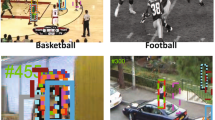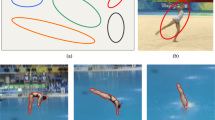Abstract
In this paper, we attempt to solve the challenging task of precise and robust human tracking from a moving camera. We propose an innovative human tracking approach, which efficiently integrates the deformable part model (DPM) into multiple-kernel tracking from a moving camera. The proposed approach consists of a two-stage tracking procedure. For each frame, we first iteratively mean-shift several spatially weighted color histograms, called kernels, from the current frame to the next frame. Each kernel corresponds to a part model of a DPM-detected human. In the second step, conditioned on the tracking results of these kernels on the later frame, we then iteratively mean-shift the part models on that frame. The part models are represented by histogram of gradient (HOG) features, and the deformation cost of each part model provided by the trained DPM detector is used to constrain the movement of each detected body part from the first step. The proposed approach takes advantage of not only low computation owing to the kernel-based tracking, but also robustness of the DPM detector without the need of laborious human detection for each frame. Experimental results have shown that the proposed approach makes it possible to successfully track humans robustly with high accuracy under different scenarios from a moving camera.








Similar content being viewed by others
References
Yilmaz, A., Javed, O., & Shah, M. (2006). Object tracking: a survey. ACM Computing Surveys, 38(4), 1–45.
Gerόnimo, D., Lόpez, A. M., Sappa, A. D., & Graf, T. (2010). Survey of pedestrian detection for advanced driver assistance systems. IEEE Transactions on Pattern Analysis and Machine Intelligence, 32(7), 1239–1258.
Comaniciu, D., & Meer, P. (2002). Mean shift: a robust approach toward feature space analysis. IEEE Transactions on Pattern Analysis and Machine Intelligence, 24(5), 603–619.
Comaniciu, D., Ramesh, V., & Meer, P. (2003). Kernel-based object tracking. IEEE Transactions on Pattern Analysis and Machine Intelligence, 25(5), 564–577.
Felzenszwalb, P. F., Girshick, R. B., McAllester, D., & Ramanan, D. (2010). Object detection with discriminatively trained part-based models. IEEE Transactions on Pattern Analysis and Machine Intelligence, 32(9), 1627–1645.
Felzenszwalb, P.F., Girshick, R.B., & McAllester, D. A. (2010). Cascade object detection with deformable part models. IEEE Conference on Computer Vision and Pattern Recognition, 2241–2248.
Girshick, R.B., Felzenszwalb, P.F., & McAllester, D.A. (2011). Object detection with grammar models. Advances in Neural Information Processing Systems, 442–450.
Chu, C.-T., Hwang, J.-N., Pai, H.-I., & Lan, K.-M. (2013). Tracking human under occlusion based on adaptive multiple kernels with projected gradients. IEEE Transactions on Multimedia, 5(7), 1602–1615.
Martinez, B., Ferraz, L., Binefa, X., & Diaz-Caro, J. (2006). Multiple kernel two-step tracking. IEEE International Conference on Image Processing, 2785–2788.
Porikli, F., & Tuzel, O. (2005). Multi-kernel object tracking. IEEE International Conference Multimedia and Expo, 1234–1237.
Fang, J., Yang, J., & Liu, H. (2011). Efficient and robust fragments-based multiple kernels tracking. International Journal of Electronics and Communications, 65, 915–923.
Liu, C., & Cheng, H. D. (2014). Multi-object tracking and occlusion reasoning based on adaptive weighing particle filter. New Mathematics and Natural Computation, 10(3), 225–238.
Cheng, H. Y., & Hwang, J. N. (2009). Adaptive particle sampling and adaptive appearance for multiple video object tracking. Signal Processing, 89(9), 1844–1849.
Hager, G.D., Dewan, M., & Stewart, C.V. (2004). Multiple kernel tracking with SSD. IEEE Conference on Computer Vision and Pattern Recognition, 790–797.
Parameswaran, V., Ramesh, V., & Zoghlami, I. (2006). Tunable kernels for tracking. IEEE Conference on Computer Vision and Pattern Recognition, 2, 2179–2186.
Fan, Z., Wu, Y., & Yang, M. (2005). Multiple collaborative kernel tracking. IEEE Conference on Computer Vision and Pattern Recognition, 2, 502–509.
Adnriluka, M., Roth, S., & Schiele, B. (2008). People-tracking-by-detection and people-detection-by-tracking. IEEE Conference on Computer Vision and Pattern Recognition, 1–8.
Branson, S., Perona, P., & Belongie, S. (2011). Strong supervision from weak annotation: Interactive training of deformable part models. IEEE International Conference on Computer Vision, 1832–1839.
Azizpour, H., & Laptev, I. (2012). Object detection using strongly-supervised deformable part models. European Conference on Computer Vision, 836–849.
Niknejad, H. T., Takeuchi, A., Mita, S., & McAllester, D. (2012). On-road multivehicle tracking using deformable object model and particle filter with improved likelihood estimation. IEEE Transactions on Intelligent Transportation Systems, 13(2), 748–758.
Shu, G., et al. (2012). Part-based multiple-person tracking with partial occlusion handling. IEEE Conference on Computer Vision and Pattern Recognition, 1815–1821.
Yao, R., et al. (2013). Part-based visual tracking with online latent structural learning. IEEE Conference on Computer Vision and Pattern Recognition, 2363–2370.
Pirsiavash, H., Ramanan, D., & Fowlkes, C.C. (2011). Globally-optimal greedy algorithms for tracking a variable number of objects. IEEE Conference on Computer Vision and Pattern Recognition, 1201–1208.
Wu, Z., Thangali, A., Sclaroff, S. & Betke, M. (2012). Coupling detection and data association for multiple object tracking. IEEE Conference on Computer Vision and Pattern Recognition, 1948–1955.
Butt, A.A., & Collins, R.T. (2013). Multi-target tracking by lagrangian relaxation to min-cost network flow. IEEE Conference on Computer Vision and Pattern Recognition, 1846–1853.
Hu, J. S., Juan, C. W., & Wang, J. J. (2008). A spatial-color mean-shift object tracking algorithm with scale and orientation estimation. Pattern Recognition Letters, 29(16), 2165–2173.
Collins, R. T. (2003). Mean-shift blob tracking through scale space. IEEE Conference on Computer Vision and Pattern Recognition, 2, II-234.
Yilmaz, A. (2011). Kernel-based object tracking using asymmetric kernels with adaptive scale and orientation selection. Machine Vision and Applications, 22(2), 255–268.
Wang, J., et al. (2004). Image and video segmentation by anisotropic mean shift. European Conference on Computer Vision, 238–249.
Bishop, C. M. (2006). Pattern Recognition and Machine Learning. Springer.
Ess, A., Leibe, B., Schindler, K., & VanGool, L. (2009). Robust multiperson tracking from a mobile platform. IEEE Transactions on Pattern Analysis and Machine Intelligence, 31(10), 1831–1846.
Wu, Y., Lim, J., & Yang, M.H. (2013). Online object tracking: a benchmark. IEEE Conference on Computer Vision and Pattern Recognition, 2411–2418.
AR Drone 2.0, link: http://ardrone2.parrot.com/
Acknowledgments
This research was supported by the National High Technology Research and Development Program of China (2013AA01A603-03, 863 Program), National Natural Science Foundation of China (61373084) and Anhui Natural Science Research Project (KJHS2015B08, KJHS2015B10, KJHS2015B02).
Author information
Authors and Affiliations
Corresponding author
Rights and permissions
About this article
Cite this article
Hou, L., Wan, W., Lee, KH. et al. Robust Human Tracking Based on DPM Constrained Multiple-Kernel from a Moving Camera. J Sign Process Syst 86, 27–39 (2017). https://doi.org/10.1007/s11265-015-1097-y
Received:
Revised:
Accepted:
Published:
Issue Date:
DOI: https://doi.org/10.1007/s11265-015-1097-y




